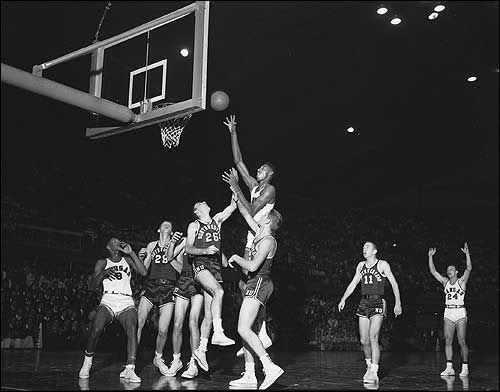

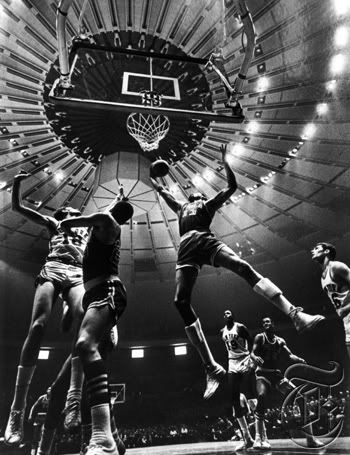
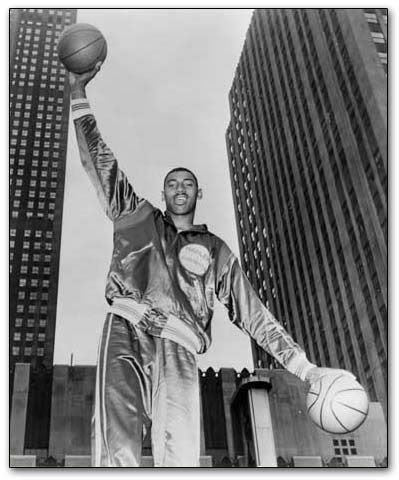
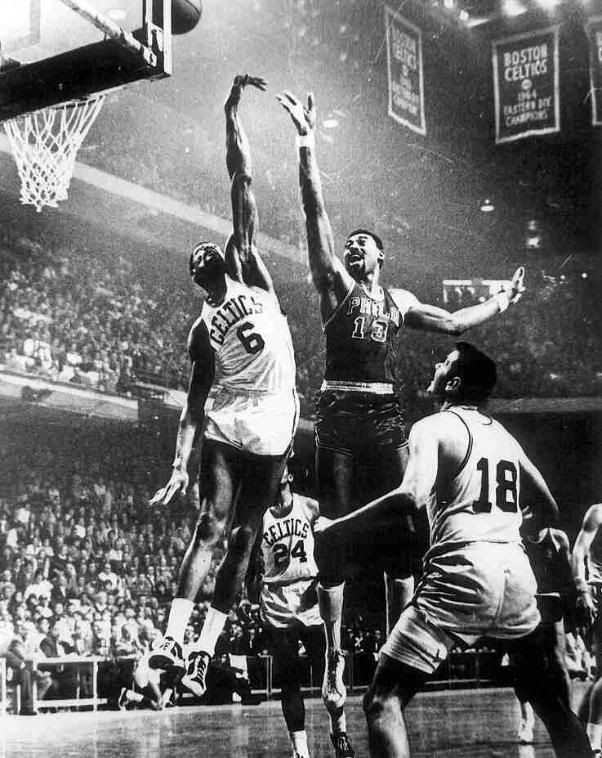
After the trade, Chamberlain found himself in a promising Sixers team that included guards Hal Greer, a future Hall-of-Famer, and talented role players Larry Costello, Chet Walker and Lucious Jackson. Cherry remarks that there was a certain tension within the team:
Greer was the formerly undisputed leader and was not willing to give up his authority, and Jackson, a talented center, was now forced to play power forward because Chamberlain blocked the center spot;
however, as the season progressed, the three began to mesh better.
Unfortunately, Chamberlain didn't care for the Sixer's coach, Dolph Schayes, because Schayes, according to him, had made several disrespectful remarks when they were rival players in the NBA.
Statistically, Chamberlain was again outstanding, posting 34.7 ppg and 22.9 rpg for the second half of the season.
After defeating the Cincinnati Royals of Oscar Robertson in the 1965 NBA Playoffs, the Sixers met Chamberlain's familiar rival, the Boston Celtics. The press called it an even matchup in all positions, even at center, where Bill Russell was expected to give Chamberlain a tough battle.
Indeed, the two teams split the first six games, and because of the better season record, the last game was held in the Celtics' Boston Garden. In that Game 7, both centers were marvelous: Chamberlain scored 30 points and 32 rebounds, and Russell logged 16 points, 27 rebounds and 8 assists.
In the final minute, Chamberlain hit two clutch free throws and slam dunked on Russell, bringing Boston's lead down to 1 at 110-109 with five seconds left. Russell botched the inbounds pass, hitting a guide wire over the backboard and giving the ball back to the Sixers.
Coach Schayes called timeout, and decided to run the last play over Hal Greer rather than Chamberlain, because he feared the Celtics would intentionally foul him because he was a poor foul shooter. But when Greer attempted to inbound the ball, John Havlicek stole it to preserve the Celtics' lead.
For the fifth time in seven years, Russell's team had deprived Chamberlain of the title.
According to Chamberlain, that was the time that people started calling him "loser".
Additionally, in an April 1965 issue of Sports Illustrated Chamberlain conducted an interview entitled "My Life In A Bush League" where he criticized his fellow players, coaches, and NBA administrators.
Chamberlain later commented that he could see in hindsight how the interview was instrumental in damaging his public image.
In the 1965-66 NBA season, the Sixers experienced real tragedy when Ike Richman, the Sixers' co-owner as well as Chamberlain's confidant and lawyer, died of a coronary. Still reeling from the shock, the Sixers posted a 55–25 regular season record, and for his strong play, Chamberlain was handed his second MVP award.
In that season, the center again dominated his opposition by scoring 33.5 points and 24.6 rebounds a game, leading the league in both categories.
In one particular game, Chamberlain blocked a dunk attempt by Gus Johnson so hard that he dislocated Johnson's shoulder.
However, off the court Chamberlain's commitment to the cause was doubted: as Chamberlain was a late sleeper, in addition lived in New York and preferred to commute to Philadelphia rather than live there, he was only available afternoon for training.
Because Schayes did not risk to anger his best player, he scheduled the daily workout at 4 pm; this angered the team, who preferred an early schedule to have the afternoon off, but Schayes just said: "There is no other way."
Irv Kosloff, who now owned the Sixers alone after Richman's death, pleaded to him to move to Philadelphia during the season, but he was turned down.
In the 1966 NBA Playoffs, the Sixers met their familiar foes, the Celtics, and for the first time even had home court advantage. However, Boston easily won the first two games on the road, winning 115–96 and 114–93; Chamberlain played within his usual range, but his supporting cast shot under 40%. This caused sports journalist Joe McGinnis to comment: "The Celtics played like champions and the Sixers just played."
In Game 3, Chamberlain scored 31 points and 27 rebounds for an important road win, and the next coach Schayes planned to hold a joint team practice. However, Chamberlain said he was "too tired" to attend, and even refused Schayes' plea to at least show up and shoot a few foul shots with the team; in Game 4, Boston won 114–108.
Prior to Game 5, Chamberlain was nowhere to be found, skipping practise and being non-accessible. Outwardly, Schayes defended his star center as "excused from practice", but his team mates knew the truth and were much less forgiving.
In Game 5 itself, Chamberlain was superb, scoring 46 points and 34 rebounds, but the Celtics won the game 120–112 and the series.
Cherry is highly critical of Chamberlain: while conceding he was the only Sixers player who performed in the series, he points out his unprofessional, egotistical behavior and being a bad example for his team mates.
Prior to the 1966-67 NBA season, the friendly but unassertive Dolph Schayes was replaced by a familiar face, the crafty but firm Alex Hannum. In what Cherry calls a tumultuous locker room meeting, Hannum addressed several key issues he observed during the last season, several of them putting Chamberlain in an unfavorable light. Sixers forward Chet Walker testified that on several occasions, players had to pull Chamberlain and Hannum apart to prevent a fistfight.
Fellow forward Billy Cunningham observed that "Hannum showed who was the boss" and "never backed down", and by doing this, won Chamberlain's respect.
When emotions cooled off, Hannum pointed out that Chamberlain and him were on the same side, trying to win a championship ring; but to pull this off, the center - like all others - needed to "act like a man" and behave accordingly on and off the court.
As a result, Chamberlain was less dominant, taking only 14% of the teams shots (in his 50.4 ppg season 1961–62, it had been 35.3%), but extremely efficient: he averaged a career-low 24.1 points, but he led the league in rebounds (24.2), ended third in assists (7.8), had a record breaking .683 field goal accuracy, and played strong defense.
For these feats, Chamberlain earned his third MVP award. The Sixers charged their way to a then-record 68–13 season, including a record 46–4 start.
In addition, the formerly egotistical Chamberlain began to praise his team mates, lauding hardworking Luke Jackson as the "ultimate power forward", calling Hal Greer a deadly jumpshooter, and point guard Wali Jones an excellent defender and outsider scorer.
Off the court, the center invited the team to restaurants and paid the entire bill, knowing he earned 10 times more than all the others.
Greer, who was considered a consummate professional and often clashed with the center because of his attitude, spoke positively of the new Wilt Chamberlain: "You knew in a minute the Big Fella [Chamberlain] was ready to go... and everybody would follow."
In the 1967 NBA Playoffs, the Sixers yet again battled the Boston Celtics in the Eastern Division Finals, and again held home court advantage. In Game 1, the Sixers beat the Boston 127–112, powered by Hal Greer's 39 points and Chamberlain's unofficial quadruple double, with 24 points, 32 rebounds, 13 assists and (unofficially counted) 12 blocks.
In Game 2, the Sixers won 107–102 in overtime, and player-coach Russell grudgingly praised Chamberlain for intimidating the Celtics into taking low percentage shots from further outside.
In Game 3, Chamberlain grabbed 41 rebounds and helped the Sixers win 115–104. The Celtics prevented a sweep by winning Game 4 with 121–117, but in Game 5, the Sixers simply overpowered the Celtics with 140–116, and the Sixers center scored 29 points, 36 rebounds and 13 assists and was highly praised by Celtics Russell and K.C. Jones.
In the 1967 NBA Finals, the Sixers were pitted against Chamberlain's old team, the San Francisco Warriors of his one-time backup Nate Thurmond and star forward Rick Barry. The Sixers won the first two games, with Chamberlain and Greer taking credit for respectively defensive dominance and clutch shooting, but San Francisco won two of the next three games, so Philadelphia was up 3–2 prior to Game 6.
In Game 6, the Warriors were trailing by one point with 15 seconds left. For the last play, Thurmond and Barry were assigned to do a pick and roll against Chamberlain and whoever would guard Barry. However, the Sixers foiled this plan: when Barry ran past Thurmond's pick and drove to the basket, he was picked up by Chet Walker, making it impossible to shoot; Thurmond was covered by Chamberlain, making it impossible to pass. Barry botched his shot attempt, and the Sixers won the championship.
Chamberlain said: "It is a wonderful to be a part of the greatest team in basketball... being a champion is like having a big round glow inside of you."
He had contributed with 17.7 ppg and 28.7 rpg against fellow future Hall-of-Fame pivot Nate Thurmond, never failing to snare at least 23 rebounds in the six games.
Chamberlain himself described the team as the best in NBA history.
In 2002, writer Wayne Lynch wrote a book about this remarkable Sixers season, Season of the 76ers, centering on Chamberlain.
In the 1967-68 NBA season, matters began to turn sour between Chamberlain and the Sixer's surviving sole owner, Irv Kosloff. This conflict had been going along for a while: in 1965, Chamberlain asserted that the late Richman and him had worked out a deal which would give the center 25% of the franchise once he had ended his career.
Although there is no written proof for or against, Ex-Sixers coach Dolph Schayes and Sixers lawyer Alan Levitt assumed Chamberlain was right; in any case, Kosloff declined the request, leaving Chamberlain livid and willing to jump to the rival ABA once his contract ended in 1967. Kosloff and Chamberlain worked out a truce, and later signed a one-year, $250,000 contract.
On the hardwood, Chamberlain continued his focus on team play and registered 24.3 points and 23.8 rebounds a game for the season.
The 76ers had the best record in the league for the third straight season. Chamberlain made history by becoming the first and only center in NBA history to finish the season as the leader in assists, his 702 beating runner-up, Hall-of-Fame point guard Lenny Wilkins's total by 23.
For these feats, Chamberlain won his fourth and last MVP title.
Another landmark was his 25,000th point, making him the first ever player to score these many points: he gave the ball to his team physician Dr. Stan Lorber.
Winning 62 games, the Sixers easily took the first playoff berth of the 1968 NBA Playoffs. In the 1968 Eastern Division Semifinals, they were pitted against the New York Knicks. In a physically tough matchup, the Sixers lost sixth man Billy Cunningham, who broke his hand, and Chamberlain, Hal Greer and Luke Jackson were struggling with respectively, inflamed feet, bad knees and pulled hamstrings. Going ahead 3–2, the Sixers defeated the Knicks 115–97 in Game 6 after Chamberlain scored 25 points and 27 rebounds: he had a successful series in which he led both teams in points (153), rebounds (145) and assists (38).
In the 1968 Eastern Division Finals, the Sixers yet again met the Boston Celtics, again with home court advantage, and this time as reigning champions. Despite the Sixers' injury woes, coach Hannum was confident to "take the Celtics in less than seven games": he pointed out the age of the Celtics, who were built around Bill Russell and guard Sam Jones, both 34.[67] But then, national tragedy struck as Martin Luther King was assassinated on April 4, 1968. With eight of the ten starting players on Sixers and Celtics being African-American, both teams were in deep shock, and there were calls to cancel the series.
In a game called as "unreal" and "devoid of emotion", the Sixers lost 118–127 on April 5. After attending Dr. King's funeral, Chamberlain called out to the angry rioters who were setting fires all over the country, stating Dr. King would not have approved.[67] In Game 2, Philadelphia evened the series with 115–106, and in Games 3 and 4, the Sixers won, with Chamberlain suspiciously often played by Celtics backup center Wayne Embry, causing the press to speculate Russell was worn down.
Prior to Game 5, the Celtics seemed dead: no NBA team had ever come back from a 1–3 deficit.
However, the Celtics rallied back, winning Game 5 with 122–104 and Game 6 with 114–106, powered by a spirited John Havlicek and helped by a terrible Sixers shooting slump.
What followed was the first of three consecutive controversial and painful Game 7s which Wilt Chamberlain played. In that Game 7, the Sixers could not get their act together: 15,202 stunned Philadelphia fans witnessed a historic 96–100 defeat, making it the first time in NBA history a team lost a series after leading 3–1. Although Cherry points out that the Sixers shot badly (Hal Greer, Wali Jones, Chet Walker, Luke Jackson and Matt Guokas hit a cumulated 25 of 74 shots) and Chamberlain grabbed 34 rebounds and shot 4-of-9, the center himself scored only 14 points.
In the second half of Game 7, Chamberlain did not attempt a single shot from the field.
Cherry observes a strange pattern in that game: in a typical Sixers game, Chamberlain got the ball 60 times in the low post, but in that Game 7, only 23 times, and only seven times in the third and only two times in the fourth quarter.
Chamberlain later blamed coach Hannum for the lack of touches (i.e. scoring opportunities), a point which the coach conceded himself, but Cherry points out that Chamberlain, who always thought of himself as the best player of all time, should have been outspoken enough to demand the ball himself.
The loss meant that Chamberlain was now 1–6 in playoff series against the Celtics.
After that season, coach Alex Hannum wanted to be closer to his family at the West Coast: he left the Sixers to coach the Oakland Oaks in the newly-founded American Basketball Association.
Chamberlain then asked for a trade, and Sixers general manager Jack Ramsay traded him for Darrall Imhoff, Archie Clark and Jerry Chambers.
The motivation for this move remains in dispute. According to sports writer Roland Lazenby, a journalist close to the Los Angeles Lakers, Chamberlain was angry at Kosloff for breaking the alleged Richman-Chamberlain deal,
but according to Dr. Jack Ramsay, who was the Sixers general manager then, Chamberlain also threatened to jump to the ABA after Hannum left, and forced the trade himself.
Cherry finally adds several personal reasons: the center felt he had grown too big for Philadelphia, searched the presence of fellow celebrities (which were plenty in L.A.) and finally also sought the opportunity to date white women, which was possible for a black man in L.A. but hard to imagine elsewhere back then.
Los Angeles Lakers
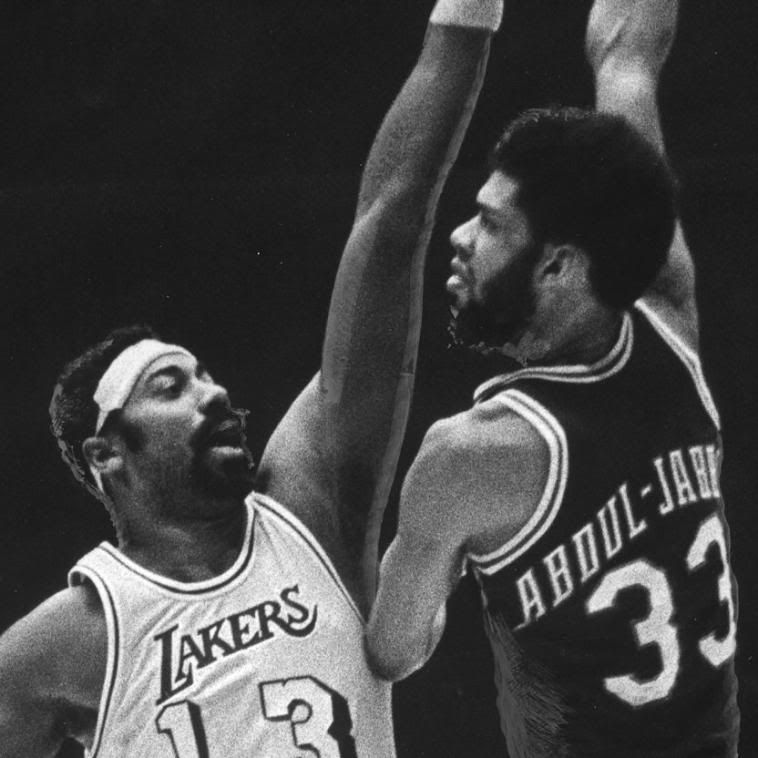

On July 9, 1968, Chamberlain was the centerpiece of a major trade between the 76ers and the Los Angeles Lakers, who sent center Darrall Imhoff (the unfortunate ex-Knicks center who started against Chamberlain when latter scored 100 points), forward Jerry Chambers and guard Archie Clark to Philadelphia, making it the first time reigning NBA Most Valuable Player was traded the next season (the other is Moses Malone 1982).
Lakers owner Jack Kent Cooke gave Chamberlain an unprecedented contract, paying him $250,000 after taxes; in comparison, previous Laker top earner Jerry West was paid $100,000 before taxes.
Chamberlain joined a squad which featured Hall-of-Fame forward Elgin Baylor and Hall-of-Fame guard Jerry West, along with backup center Mel Counts, forwards Keith Erickson and Tom Hawkins and talented but diminutive 6' guard Johnny Egan. The lack of a second guard next to West (and thus, the lack of speed and quickness) concerned coach Bill Van Breda Kolff; after losing Clark and Gail Goodrich, who joined the Phoenix Suns after the 1968 expansion draft, he said: "Egan gets murdered on defense because of his [lack of] size... but if I don't play him, we look like a bunch of trucks."
In addition, Cherry observed that Chamberlain was neither a natural leader nor a loyal follower, which made him difficult to fit in.
While he was on cordial terms with Jerry West, he often argued with team captain Elgin Baylor; latter explained later: "We were good friends, but... [in] black culture... you never let the other guy one-up you."
The greatest problem was his tense relationship with Lakers coach Butch Van Breda Kolff: pejoratively calling the new recruit "The Load", he later complained that Chamberlain was egotistical, never respected him, too often slacked off in practice and focused too much on his own statistics.
In return, the center blasted Van Breda Kolff as "the dumbest and worst coach ever". Laker Keith Erickson observed that "Butch catered to Elgin and Jerry... and that is not a good way to get on Wilt's side... that relationship was doomed from the start."
Chamberlain experienced a problematic and often frustrating season. Van Breda Kolff benched him several times, which never happened in his career before; in mid-season, the perennial scoring champion had two games in which he scored only six and then only 2 points.
Playing through his problems, Chamberlain averaged 20.5 points and 21.1 rebounds a game that season.
However, Jack Kent Cooke was pleased, because since acquiring Chamberlain, ticket sales had gone up by 11 percent.
In the the playoffs, the Lakers dispatched of Chamberlain's old club, the San Francisco Warriors with 4–2 after losing the first two games, and then defeated the Atlanta Hawks and met Chamberlain's familiar rivals, Bill Russell's Boston Celtics.
Going into the series as 3-to-1 favourites, the Lakers won their first two games, but dropped the next two. Chamberlain was criticized as a non-factor in the series, getting neutralized by Bill Russell with little effort.
But in Game 5, the Lakers center struck back, grabbed 31 rebounds and led Los Angeles to a 117-104 win. In Game 6, the Celtics won 99–90, and Chamberlain only scored eight points; Cherry accuses him of choking, because if "Chamberlain had came up big and put up a normal 30 point scoring night", L.A. would have probably won its first championship.
Game 7 featured a surreal scene: in anticipation of a Lakers win, Lakers owner Jack Kent Cooke had put up thousands of balloons in the rafters of the Forum in Los Angeles. This display of arrogance motivated the Celtics and angered Jerry West.
In that match, Chamberlain experienced his second Game 7 debacle. The Lakers trailed by 76–91 after three quarters. But powered by a limping Jerry West, who played with a deep thigh bruise after Game 5, the Lakers mounted a comeback; but then, Chamberlain twisted his knee after a rebound and had to be replaced by Mel Counts. With three minutes to go, and West and Counts hitting clutch baskets, the Lakers trailed by only 102–103.
But when the Celtics tightened up their defense, the Lakers committed costly turnovers and lost the game 106–108 despite 42 points, 13 rebounds and 12 assists of Jerry West, who became the first and only NBA Finals MVP from the losing team.
After the game, the key question was why Chamberlain had stayed out the final six minutes. At the time of his final substitution, he had scored 18 points (hitting 7 of his 8 shots) and grabbed 27 rebounds, significantly better than the 10 points of Mel Counts on 4-of-13 shooting.
To justify a late minute sub, either Chamberlain's injury had to be grave, or Van Breda Kolff's trust in Counts absolute. Among others, Bill Russell did not believe Chamberlain's injury was grave, and openly accused him of being a malingerer: "Any injury short of a broken leg or a broken back is not enough."
Ironically, Van Breda Kolff came to Chamberlain's defense, insisting the often-maligned Lakers center hardly was able to move in the end.
He himself was perceived as "pig-headed" for benching Chamberlain, and soon resigned as a Lakers coach.
Cherry comments that according to some journalists, that Game 7 "destroyed two careers: Wilt's because he wouldn't take over and Van Breda Kolff because he wouldn't give in".
In his second Lakers year under new coach Joe Mullaney, Chamberlain seriously injured his knee. He missed almost the entire 82-game regular season, only appearing in the final 12 games, but managed to average 27.3 points, 18.4 rebounds and 4.1 assists per game.
Again, the Lakers charged through the playoffs, and in the 1970 NBA Finals, the Lakers were pitted against the New York Knicks, loaded with future Hall-of-Famers Willis Reed, Dave DeBusschere, Bill Bradley, and Walt Frazier. Cherry observed that Reed, a prolific midrange shooter, was a bad matchup for Chamberlain: having lost lateral quickness due to his injury, the Lakers center was often too slow to block Reed's preferred high post jump shots.
In Game 1, Reed masterminded a 124–112 win in which he scored 37 points on Chamberlain. In Game 2, Chamberlain scored 19 points, grabbed 24 rebounds and blocked Reed's shot in the final seconds, leading the Lakers to a 105–103 win.
Game 3 featured Jerry West hitting an unbelievable 60-foot buzzer beater to tie the game at 102; however, the Knicks took the game 111–108.
In Game 4, Chamberlain scored 18 points and grabbed 25 rebounds and helped tie the series at two games each.[74] But in Game 5, things seemed to go awry for the Knicks: trailing by double digits, Reed pulled his thigh muscle and seemed to be done for the series. By conventional wisdom, Chamberlain now should have dominated against little-used Knicks backup centers Nate Bowman and Bill Hosket or forwards Bradley and DeBusschere, who gave up more than half a foot against the Lakers center.
Instead, the Lakers gave away their 13 point halftime lead and succumbed to the aggressive Knicks defense: L.A. committed 19 second half turnovers, and the two main scorers Chamberlain and West shot the ball only three and two times, respectively, in the entire second half.[74] The Lakers lost 100–107 in what was called one of the greatest comebacks in NBA Finals history.
In Game 6, Chamberlain scored 45 points and almost single-handedly equalized the series in a 135–113 Lakers win, and with Reed out, the Knicks seemed doomed prior to Game 7 in New York.
However, the hero of that Game 7 was Willis Reed. He famously hobbled up court, scored the first four points, and inspired his team to one of the most famous playoff upsets of all time.
t halftime, the Knicks were already up by 27, and despite scoring 21 points, Chamberlain could not prevent his third consecutive painful Game 7 loss. The Lakers center himself was criticized for his inability to dominate his injured counterpart, but Cherry pointed out that Chamberlain's feat - coming back from career-threatening injury himself - was too quickly forgotten.
In the 1970-71 NBA season, the Lakers made a notable move by signing future Hall-of-Fame guard Gail Goodrich, who came back from the Phoenix Suns after playing for L.A. until 1968. Chamberlain averaged 20.7 points, 18.2 rebounds and 4.3 assists,
once again led the NBA in rebounding and the Lakers won the Pacific Division title. After losing Elgin Baylor to an Achilles tendon rupture that effectively ended his career, and especially after losing Jerry West after a knee injury, the handicapped Lakers were seen as underdogs against the Milwaukee Bucks of freshly-crowned MVP Lew Alcindor, better known under his later Muslim name Kareem Abdul-Jabbar, and veteran Hall-of-Fame guard Oscar Robertson in the Western Conference Finals. Winning the regular season with 66 wins, the Bucks were seen as favourites against the depleted Lakers; still, many pundits were looking forward to the matchup between the 34-year old Chamberlain and the 24-year old Abdul-Jabbar.
In Game 1, Abdul-Jabbar outscored Chamberlain 32–22, and the Bucks won 106–85. In Game 2, the Bucks won again despite the Lakers center scoring 26 points, four more than his Milwaukee counterpart. Prior to Game 3, things became even worse for the Lakers when Keith Erickson, West's stand-in, had an appendectomy and was out for the season; with only rookie Jim McMillan easing the scoring pressure, Chamberlain churned out a 24-point-24-rebound effort in Game 4 to a Lakers win, but finally the Bucks soundly defeated the Lakers 116–98 at home.
Although Chamberlain lost, he was lauded for holding his own against MVP Abdul-Jabbar, who was not only 10 years younger but still had two healthy knees.
After the 1971 playoffs, Chamberlain had an offer to fight heavyweight boxing legend Muhammad Ali. The 15-round fight would have taken place on July 26, 1971 in the Houston Astrodome but Chamberlain finally refused the match.[19] In an 1999 interview, Chamberlain stated that boxing trainer Cus D'Amato wanted to train him for the fight, and they offered Ali and him $5 million each to battle each other. However, after checking back with his father, Chamberlain finally said no.
In the 1971-72 NBA season, the Lakers hired former Celtics star guard Bill Sharman as head coach. Sharman introduced morning shoot-arounds, in which the perennial latecomer Chamberlain regularly participated (in contrast to earlier years with Dolph Schayes) and transformed him into a defensive-minded, low-scoring post defender in the mold of his old rival Bill Russell.
Furthermore, he told Chamberlain to use his rebounding and passing skills to quickly initiate fastbreaks to his teammates, forwards Happy Hairston and MacMillian, guards Goodrich and West, and bench players Flynn Robinson and LeRoy Ellis.
While no longer being the main scorer, Chamberlain was named the new captain of the Lakers: after his Achilles tendon rupture, perennial captain Elgin Baylor had ended his career, leaving a void the center now filled. Initially, Sharman had wanted Chamberlain and West to share this duty, but West declined, stating that he was injury-prone and wanted to solely concentrate on the game.
Chamberlain accepted his new roles and posted an all-time low 14.8 points, but also won the rebound crown with 19.2 rpg and led the league with a .649 field goal percentage.
Powered by his defensive presence, the Lakers would embark on an unprecedented 33 game win streak en route to a then-record 69 wins in the regular season.
In the post-season, the Lakers defeated the Chicago Bulls in a sweep,
then went on to face the Milwaukee Bucks of young superstar center and regular-season MVP Kareem Abdul-Jabbar again. The matchup between Chamberlain and Abdul-Jabbar was hailed by LIFE magazine as the greatest matchup in all of sports. Chamberlain would help lead the Lakers past Jabbar and the Bucks in 6 games.
Particularly, Chamberlain was lauded for his final Game 6 performance, which the Lakers won 106–100 after trailing by 10 points in the fourth quarter: he scored 24 points and 22 rebounds, played a complete 48 minutes and outsprinted the younger Bucks center on several late Lakers fast breaks.
Jerry West called it "the greatest ball-busting performance I have ever seen."
In the 1972 NBA Finals, the Lakers again met the New York Knicks; the Knicks were shorthanded after losing Willis Reed to injury, and so, undersized 6'8" Jerry Lucas had the task to defend against the 7'1" Chamberlain.
However, prolific outside shooter Lucas helped New York to win Game 1, hitting 9 of his 11 shots in the first half alone; in Game 2, which the Lakers won 106–92, Chamberlain put Lucas into foul trouble, and the Knicks lost defensive power forward Dave DeBusschere to injury.
In Game 3, Chamberlain scored 26 points and grabbed 20 rebounds for another Lakers win, and in a fiercely battled Game 4, the Lakers center was with playing with five fouls late in the match. Having never fouled out in his NBA career - a feat he was very proud of - he played aggressive defense despite the risk of fouling out, and blocked two of Lucas' shots in overtime, proving those wrong who said he only played for his own stats; he ended scoring a game-high 27 points.
But in that game, he had fallen on his right hand, and was said to have "sprained" it; in fact, it was broken. For Game 5, Chamberlain's hands were packed into thick pads normally destined for defensive linesmen in American Football; he was offered a painkilling shot, but refused because he feared he would lose his shooting touch if his hands became numb.
In Game 5, Chamberlain scored 24 points, 29 rebounds, and helped the L.A. Lakers win their first championship with a decisive 114–100 win. Chamberlain was named Most Valuable Player of the NBA Finals,[and was admired for dominating the Knicks in Game 5 while playing injured.
The 1972-73 NBA season was to be Chamberlain's last, although he did not know this at the time. In his last NBA year, the Lakers had lost substance: Happy Hairston was injured, Flynn Robinson and LeRoy Ellis had left L.A., and veteran Jerry West struggled with sensitive hamstrings.
Chamberlain averaged 13.2 points and 18.6 rebounds, still enough to win the rebounding crown for the 11th time in his career. In addition, he shot with an all-time NBA record .727 accuracy from the field, bettering his own mark of .683 from the 1966–67 season — neither percentage has been topped by any other player.
It was the ninth time Chamberlain would lead the league in field goal percentage. The Lakers won 60 games in the regular season and reached the 1973 NBA Finals against the New York Knicks. This time, the tables were turned: the Knicks now featured a healthy team with a rejuvenated Willis Reed, and the Lakers were now handicapped by several injuries.
In that series, the Lakers won Game 1 with 115–112, but the Knicks won Games 2 and 3; things worsened when Jerry West injured his hamstring yet again. In Game 4, the shorthanded Lakers were no match for New York, and in Game 5, the valiant, but injured West and Hairston had miserable games, and despite Chamberlain scoring 23 points and grabbing 21 rebounds, the Lakers lost 93-102 and the series.
Chamberlain did not yet know that this loss was the last professional game of his career.
Post-NBA career
After his stint with the Qs, Chamberlain successfully went into business and entertainment, made money in stocks and real estate, opened a popular Harlem nightclub, Big Wilt's Smalls Paradise, and invested in broodmares.
Chamberlain also sponsored his personal professional volleyball and track and field teams, and also provided high-level teams for girls and women in basketball, track, volleyball and softball,and made money by appearing in ads for Drexel Burnham, Le Tigre Clothing and Foot Locker.
After his basketball career, volleyball became Chamberlain's new passion: being a talented hobby volleyballer (albeit due to lack of technique, not as excellent as volleyball All-American Lakers team mate Keith Erickson) during his Lakers days,[87] he became board member of the newly founded International Volleyball Association in 1974 and became its president one year later.
As a testament to his importance, the IVA All-Star game was only televised because Chamberlain also played in it: he rose to the challenge and was named the game's MVP.
He played occasional matches for the IVA Seattle Smashers before the league folded in 1979. However, Chamberlain had promoted the sport so effectively that he was named to the Volleyball Hall of Fame: he became one of the few athletes who were enshrined in different sports.
In addition, Chamberlain played the villain in the Arnold Schwarzenegger film Conan the Destroyer (1984), where his most remarkable spoken phrase is "thieves should be hanged": this caused his physician Dr. Lorber to jokingly greet Chamberlain with "thieves should be hanged" whenever they met.[91] When million-dollar contracts became common in the NBA, Chamberlain increasingly felt he had been underpaid during his career.
A result of this resentment was the 1997 book Who's Running the Asylum? Inside the Insane World of Sports Today (1997), in which he harshly criticized the NBA of the 1990s for being too disrespectful of players of the past.
Even far beyond his playing days, Chamberlain was a very fit person. In his mid-forties, he was able to humble a young Los Angeles Lakers rookie called Magic Johnson in practice, and even in the 1980s, he flirted with making a comeback in the NBA. In the 1980-81 NBA season, coach Larry Brown recalled that the 45-year old Chamberlain had received an offer by the Cleveland Cavaliers. When Chamberlain was 50, the New Jersey Nets had the same idea, and Chamberlain declined again.
Chamberlain however participated in several marathons instead.
He would stay an epitome of physical fitness for years to come, until his health rapidly worsened in 1999.






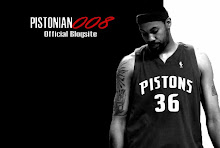
No comments:
Post a Comment